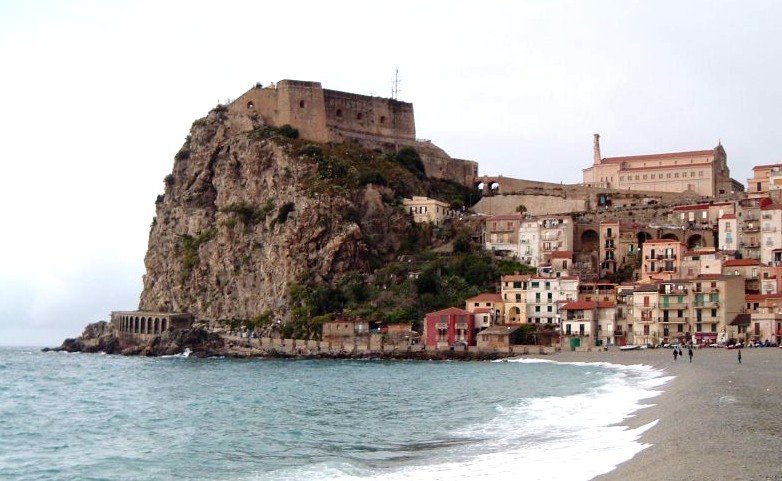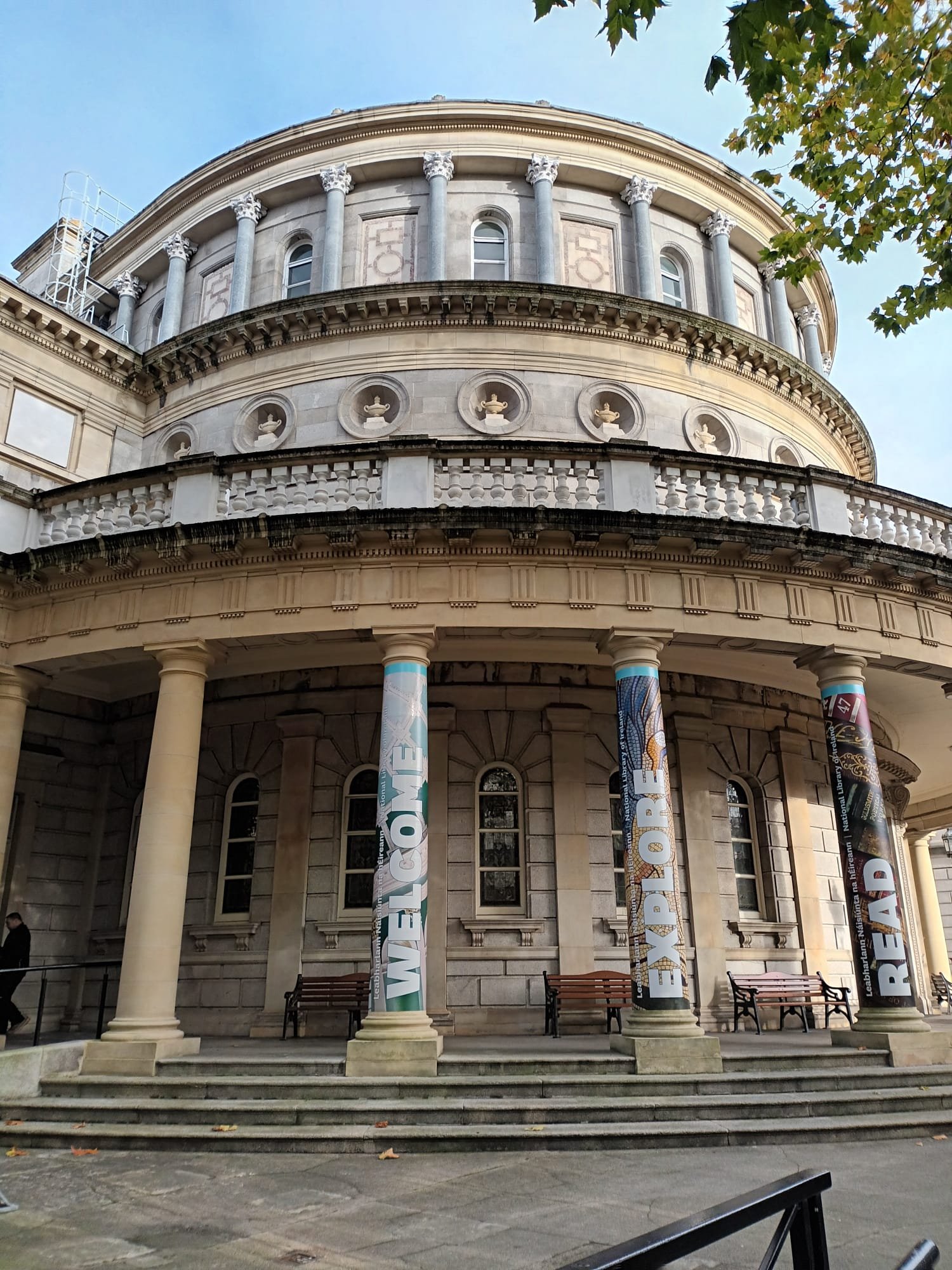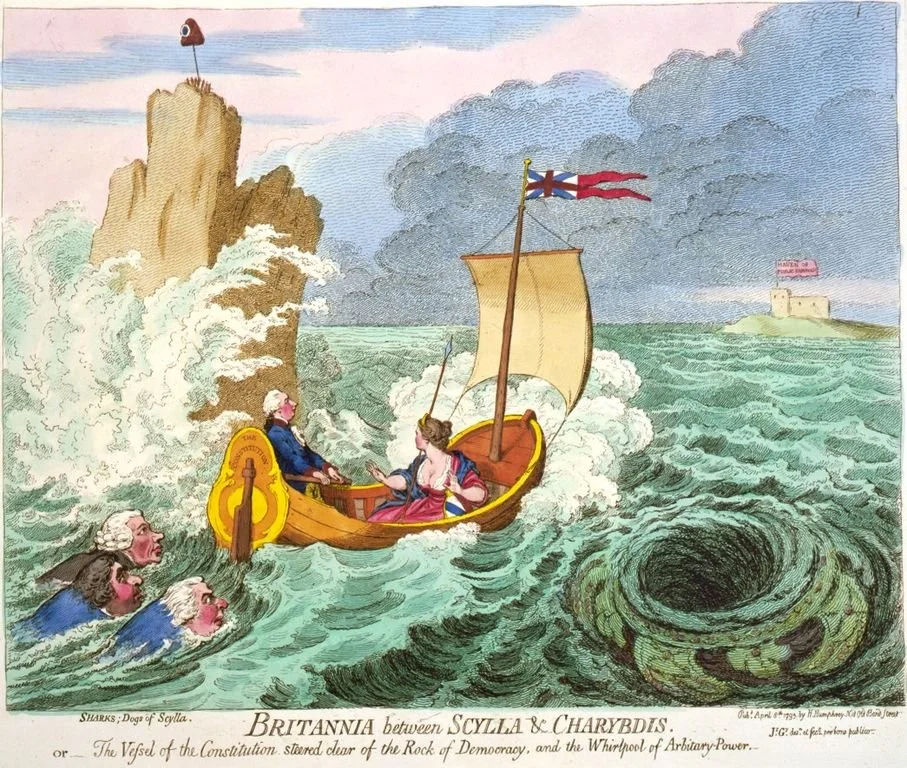Ulysses & The Odyssey: Scylla & Charybdis
“[The paternity motif], which, applied to the Godhead, has been so fruitful a cause of misunderstanding and dissension in the Christian Church, that this episode is the subtlest and hardest to epitomize of all the eighteen episodes of Ulysses.” - Stuart Gilbert
“The Aristotelian and Platonic philosophies are the monsters that lie in wait in the narrows for the thinker.” - James Joyce to Frank Budgen
The Odyssey - Book XII
After departing the Underworld, Odysseus and his remaining crew set sail once more, leaving Circe’s isle and passing the land of the Sirens without incident. They must next sail their ship between the twin horrors of Scylla and Charybdis. Circe advised Odysseus to steer close to the Wandering Rocks, home of Scylla, a terrible six-headed, twenty-legged beast. Scylla would surely devour some of the crew, but their fate would be far worse if they steered too close to Charybdis, an enormous maelstrom capable of swallowing ships whole. Odysseus heeds Circe’s warnings, and though he loses six of his best crewmen to the dread Scylla, the survivors live to sail another day. (For now, anyway.)
It’s finally Stephen’s time to shine in “Scylla and Charybdis,” the ninth episode of Ulysses. Since Stephen first peaked out from the shadows atop the Martello Tower on page one, he has been mentally fortifying himself for his big showdown in the National Library, during which he will defend his idiosyncratic theory of Hamlet’s parentage. The mocker Buck Mulligan denigrated Stephen’s thesis earlier that morning in the presence of the Englishman Haines, who was intrigued by Stephen’s ideas:
“—Pooh! Buck Mulligan said. We have grown out of Wilde and paradoxes. It’s quite simple. He proves by algebra that Hamlet’s grandson is Shakespeare’s grandfather and that he himself is the ghost of his own father.
—What? Haines said, beginning to point at Stephen. He himself?”
As Stephen finally takes centre stage in “Scylla and Charybdis,” Mulligan crashes the party late, while Haines is completely absent. Stephen has no time to trouble himself with those two as he has a new audience in the Library upon which to bestow his rhetorical gifts. Despite this, Stephen is not sailing in friendly waters. By framing Stephen’s debate in the Library in terms of its parallel encounter in The Odyssey, we can truly appreciate how perilous his situation truly is.
The rock of Scilla, Calabria, Italy (Source)
In The Odyssey, Scylla is a terrible, six-headed beast lurking atop a cliff face so steep and so smooth that it is impossible for mortals to scale it. The rocks lie near the Straits of Messina, a narrow, treacherous sea passage between Sicily and mainland Italy. Shipwrecks were a regular occurrence on the rocks beneath the Calabrian village of Scilla, named for the mythical beast from Homer’s epic. Legend has it that a cave in the sea cliff to the west of Scilla was home to the village’s namesake. Luckily for modern seafarers, Scylla’s cave collapsed in an earthquake in the 1780’s, ending the fell beast’s reign of terror over the Strait.
Stephen Dedalus only has to fear rhetorical sea monsters on the choppy waves of dialectic in the Library, though. In this episode, Scylla corresponds with dogmatic, Aristotelian rhetoric, solid and unyielding like Scylla’s own rock. Through a Joycean chain of associations, Scylla corresponds, via Aristotle, to the writings of Thomas Aquinas, and via Aquinas, to the Catholic Church, itself established by St. Peter, whose name derives from the Greek for “rock.” Naturally then, the idea of Scylla also encompasses the Jesuits who educated Stephen Dedalus/James Joyce. Like Odysseus, Stephen steers toward the lair of Aristotle/Scylla while defending his theory, incurring what casualties he must, just like Odysseus before him, to support his tenuous Shakespeare theory against the onslaught of doubters in the Library.
In the article “Rhetoric and Homeric Paradigm in ‘Scylla and Charybdis,’” scholar Craig Hamilton zeroes in on the image of those “six men taken” by the monster Scylla from Odysseus’ crew. Stephen, much more so than Bloom, takes on the Odysseus role in this episode, steering hard into the rocky Aristotle/Scylla side of this rhetorical strait. In doing so, Stephen accepts the dogma of Aristotle, and by extension, the wrath of Scylla. Hamilton sees Stephen’s alliance with a man-eating sea monster foreshadowed in Mulligan’s quip in “Telemachus”:
“Come out, Kinch. You have eaten all we left, I suppose.”
Hamilton argues that Stephen, like Scylla, does indeed “take” six men along for a ride as he argues his Shakespeare theory. The first four men “taken” by Stephen/Scylla are clear - Æ, John Eglinton, assistant director Dr. Richard Best and librarian Thomas Lyster are all devoured one by one by Stephen’s intellect. Each is snubbed or pettily thwarted in one way or another as the episode rolls along. Hamilton considers Mulligan and Bloom to be the final two crew members that must pass beneath Stephen’s wrathful watch, though they seem to be spared by the dread beast.
On the other side of the coin, Charybdis is a monstrous version of the real whirlpools and unpredictable currents that plague ships in the Straits of Messina, and for Stephen, represents the whirling, mystical Platonic worldview. Charybdis’ champion in our oratorical duel is the mastermystic Æ, the founder and leader of Dublin’s theosophical and hermetic societies and promoter of Celtic Twilight literature. Charybdian thought is represented in the romanticism of Blake and is often described as “incoherent” in commentary on this episode. It’s worth considering that Odysseus found Charybdis far more deadly than the ravening Scylla. Charybdis is shifting and ever changing, and its destruction is total. Stephen is aware of the danger lurking in Aristotelian dogma, but it’s telling that he regards his rival Æ as an “engulfer of souls”; the magical thinking of Dublin’s occult circles represents a far more treacherous path for our young Artist. (Rhetorically, anyway.)
What is one to do in the face of such grievous (oratorical) danger? Luckily for us readers, Joyce has equipped us with an array of correspondences to help navigate the straits of “Scylla and Charybdis.” Tellingly, the correspondent organ for this episode is the brain, the battlefield for Stephen and his monsters. Stuart Gilbert, author of Ulysses: A Study, deemed the brain the “cruellest of all the instruments that man has forged for his own undoing.” An intellectual like Stephen lives and dies by their brain, so luckily he’s showing up to this knowledge fight well-armed. Stephen was present for several of the rhetorical recitations presented by the newsmen back in the “Aeolus” episode, but note that the correspondent organ of that episode is the lungs. The oratory of the likes of Seymour Bushe and John F. Taylor is eloquent and powerful enough to stir listeners’ sentiments, but the rhetorical premises upon which they are built fall apart rapidly upon inspection. The rhetoric of “Aeolus” is created from the hot air produced by bloviating journalists and is therefore of little use to Stephen the Artist.
The National Library of Ireland, November 2023
Stephen has chosen a suitable battleground for his brainy confrontation. In the book James Joyce’s Ulysses: Critical Essays, scholar Robert Kellogg describes the National Library as the premier educational institution in Dublin outside of Trinity College. Trinity is and was an elitist institution whose doors (and library) are only open to a select few, and in Joyce’s day, a select Protestant few. The National Library was a place where students, intelligentsia and ordinary Dubliners alike might simply cross paths or even “break a lance” in discussion, as Mr. Deasy might say.
Stephen’s Shakespeare theory is based on James Joyce’s own similar theory. Joyce also presented his theory in 1904 in the National Library to the real Eglinton, Best and Oliver St. John Gogarty (the real-life model for Mulligan), who presumably were similarly unimpressed like their fictionalized counterparts. One difference in the two scenarios is that Stephen is very quick to deny any belief in his own convoluted theory, while Joyce apparently dug in his heels and, according to Kellogg, never admitted to any doubt. Joyce rewrote a tale of his own life here but changed the one detail that perhaps irritated him so many years later - his own foolish stubbornness. Anyone looking back on such unabashed, youthful bravado in their maturity must feel some retroactive embarrassment, but Joyce is able to weave any lingering shame into one of the most complex and compelling episodes of his literary epic.
Joyce is not completely gentle on his fictionalized subjects, though. The Stephen we meet in “Scylla and Charybdis” is analogous to the James Joyce who wrote “The Holy Office,” a poem so vitriolic towards Dublin’s literary establishment that it was unpublishable in its day. Joyce, never one to abandon a perfectly good grudge, snarkily maintains some of his youthful perturbations in this episode: the blandness of these literary influencers and their disconnect from the day-to-day struggles of most Dubliners. Worst of all, they were unwilling to uplift a young, struggling artist whose talent outshone them all (at least in the view of the young artist). Worst-worst of all, they invited Buck Mulligan to their poetry party while snubbing that same young Artist. Hamilton believes that Æ’s real-life exclusion of James Joyce from the poetry collection New Songs is a reason his role in “Scylla and Charybdis” is so brief.
Joyce not only oriented “Scylla and Charybdis” to the perfect place for intellectual sparring, but also to the perfect time of day. He told his friend Frank Budgen that early afternoon (“Scylla and Charybdis” takes place around 2:00 pm) is the time of greatest brain activity. He felt a light lunch especially stimulates the mind. Notice how Stephen defers his Shakespeare speech in “Telemachus” on the grounds that, “We are always tired in the morning. And it is rather long to tell.” Stephen is running on a liquid lunch of at least three drams of whiskey by the time he treads the boards in the Library, so while he may have mustered enough courage to perform, he may in fact be edging on recklessness.
“Scylla and Charybdis” corresponds with an art and technic in Joyce’s schema, as well. The correspondent art of “Scylla and Charybdis” is literature (though one would be forgiven for wondering if that were the art of the whole of Ulysses). Joyce had very distinct and specific ideas about literature as an art form. In A Portrait of the Artist as a Young Man, Stephen defines three forms of literature: lyrical, epic and dramatic:
“...art necessarily divides itself into three forms progressing from one to the next. These forms are: the lyrical form, the form wherein the artist presents his image in immediate relation to himself; the epical form, the form wherein he presents his image in mediate relation to himself and to others; the dramatic form, the form wherein he presents his image in immediate relation to others.”
Gilbert points out that all three of these forms are present in “Scylla and Charybdis,” in the form of lyrics, blank verse, and the section towards the end that is written as the script to a play. The demands of these shifting styles, interspersed with various Elizabethan idioms, push the traditional notion of literature to its limits, demonstrating that Ulysses is no common novel.
Kellogg wrote that Joyce considered prose literature to be a lower art form, mainly concerned with the ins and outs of society and individual people’s lives. In the Joycean hierarchy, poetry more adequately deals with higher, capital-T Truths, unreachable by literature. At the peak of Joyce’s pyramid is drama, with the plays of Henrik Ibsen being the greatest examples of the greatest artform. Kellogg points out that though Joyce’s hierarchy represents some extremes of opinion, all the steps of this artistic hierarchy unite in the figure of Shakespeare - a dramatist, poet and literary artist all rolled into one. Kellogg noted that “truth is the midway” between these two poles, and apparently ol’ Shakes falls dead center. We should also note, as I’m sure Joyce did, that Joyce’s creative oeuvre also encompasses poetry, drama and literature and occupied itself with the most mundane circumstances portrayed in elaborate layers of correspondence indicating those deeper Truths. As Stephen begins to find his artistic feet in “Scylla and Charybdis,” his mind is tuned to these same creative wavelengths, transmitted directly from the brain of his Creator.
A political cartoon from the 1790’s depicting William Pitt the Younger sailing between Scylla and Charybdis (Source)
The double perils of Scylla and Charybdis represent for Stephen the intractable problem of difficult dualities. The distasteful act of choosing between two evils is known to most of us, and this is exactly the conundrum in which Stephen finds himself here. Navigating between literal sea monsters is difficult enough, though few of us will ever have to strategize in this way. We are far more likely to navigate between treacherous ideas, much like Stephen. Unlike with sea monsters, we are not beholden to choose A or B. It is exceedingly rare that one must actually choose one of those two proverbial evils. The best and only way to solve an unsolvable binary is not to simply steer into the rocks and hope that Scylla doesn’t devour anyone too valuable, but to seek out a third way. We don’t actually have to stake a claim on Team Aristotle or Team Plato. Wisdom tells us that both of these ancient philosophers have something valuable to offer, and the real danger lies in accepting all of one and none of the other. Harsh, intractable ideology does no one any favors.
Scholar Richard Ellmann, in his book Ulysses on the Liffey, writes that this is just the way that our oratorical Scylla and Charybdis must be circumvented. Viewing the world in terms of Scylla or Charybdis, Aristotle or Plato, Left or Right, Mother or Father limits us to the point of destruction. Ellmann suggests we all need to get a bit more nonbinary in order to actually achieve wisdom and access that capital-T Truth. “The way to escape the dangers of Scylla and Charybdis,” he wrote, “is to mate them,” forming, in Ellmann’s reckoning, “the beast with two backs.” An Artist must embody both sides of these dualities, combining aspects of both parents in the process of creation. The art of a Mulligan or an Æ is all yang or all yin. It is essentially unbalanced and, as a result, false art. Ellmann goes so far as to describe this type of art as masturbatory (this is especially clear in the creations of Mulligan). True, all-encompassing Art comes from a source that balances both sides of the duality - a so-called “womanly man” like Leopold Bloom (a description Joyce also self-applied). Ellmann wrote that if Stephen can learn to overcome this divide, then he too can finally transcend his sonhood and, like Shakespeare in his own theory, become his own father.
Further Reading:
Budgen, F. (1972). James Joyce and the making of Ulysses, and other writings. London: Oxford University Press. Retrieved from https://search.library.wisc.edu/digital/AMF2PZFZHI2WND8U
Ellmann, R. (1959). James Joyce. Oxford University Press.
Ellmann, R. (1972). Ulysses on the Liffey. Oxford University Press. Retrieved from https://archive.org/stream/in.ernet.dli.2015.65767/2015.65767.Ulysses-On-The-Liffey_djvu.txt
Gilbert, S. (1955). James Joyce’s Ulysses: a study. New York: Vintage Books. Retrieved from https://archive.org/details/in.ernet.dli.2015.124373/page/n3/mode/2up
Hamilton, C. A. (1998). Rhetoric and Homeric Paradigm in “Scylla and Charybdis.” James Joyce Quarterly, 35/36, 864–866. http://www.jstor.org/stable/25473963
Homer, translated by Palmer., G.H. (1912). The Odyssey. Mineola, New York: Dover Publications
Kellogg, R. (1974). Scylla and Charybdis. In C. Hart & D. Hayman (eds.), James Joyce’s Ulysses: Critical essays (147-179). Berkeley: University of California Press. Retrieved from https://tinyurl.com/wu2y7mg
Kenner, H. (1987). Ulysses. Baltimore: The Johns Hopkins University Press.
Sun, L. Scylla and Charybdis - Modernism Lab. Retrieved from https://campuspress.yale.edu/modernismlab/scylla-and-charybdis/




